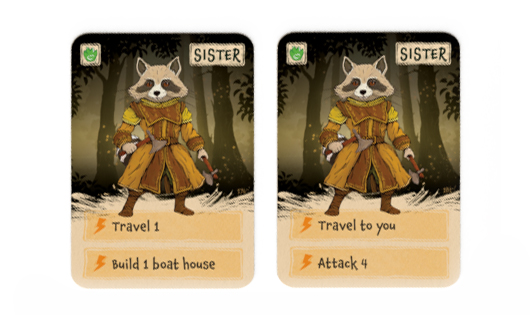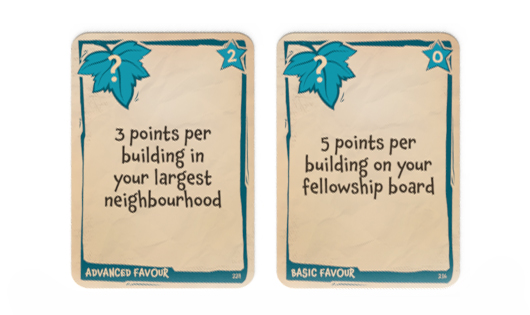What to expect from Emberleaf’s solo mode

For a number of years now, solo modes have been just as important to me as the multiplayer mode. I start thinking about how they might work from the very beginning, always considering how any game design decisions will impact both the multiplayer and solo experience.
I design my solo modes with two goals in mind. First, the solo mode should require as little management from the player as possible. Secondly, the solo mode should mirror the multiplayer experience as closely as possible. You should feel like you’re playing against another person, not just trying to achieve a high score.
Managing your sister
In Emberleaf, the opponent you play against in solo mode is your sister, who’s doing everything she can to win the hearts of the Emberlings over you. She uses four decks of cards:
- Two decks contain special favour (objective) cards. During setup, you’ll reveal 0-3 cards from each deck depending on the difficulty you choose.
- The third deck consists of five cards, one for each building type. These are placed face-down in a row, with only the first card revealed.
- The fourth deck is the action deck, which defines what your sister does on her turn.
On your turn, you play just like in the multiplayer game, following all the normal rules. On your sister’s turn, you count the stamina used on her previously played cards. If it’s less than five, you flip over an action card and resolve the two skills on it. Each action card has 0-2 stamina, so around every five turns, she’ll hit that five-stamina threshold. When she does, instead of flipping a new action card, you discard the action cards in play and flip the next building card from the row.

Each skill is simplified, removing any need for decision-making on the sister’s behalf, ensuring you can resolve her turns quickly without confusion. If a choice must be made, you make the one most beneficial to you. The idea behind this is that rather than having to try and think about what the other player might do, choosing what’s best for her, you can instead spend that thinking energy on your own strategy and how this decision can best help you achieve your goals, enhancing the experience rather than diminishing it.
Maintaining the multiplayer feel
To make sure the solo mode feels like a multiplayer game, I started with a simple rule: the human player’s rules should not change. The only difference is managing the sister player. Furthermore, instead of your sister trying to directly score points for herself, she takes actions that simulate the interactions of playing against a real opponent.
Her skills include removing hero and favour cards from the display. She doesn’t keep or use those cards, but it simulates the experience of a real player snapping up options you wanted, forcing you to adjust your plans. She can also clear dangerous areas, progress the war banner track, take trophies, and build buildings—just like a human player would.
Importantly, some of her action cards are designed to break predictability. For example, she might shuffle all her action cards back into the deck, so just because you’ve already seen her play a specific card doesn’t mean she won’t get it again on her next turn.
Scoring
Where the solo mode differs from multiplayer is in the scoring system. Your sister scores based on the favour cards she was given during setup, which are tied to your actions.

From the start, you know what your sister will score for. For instance, she might get five points for each clearing that doesn’t contain a rat. This means you can either work to home as many rats as possible or allow her to gain points. Similarly, she might score for the dangerous areas you’ve cleared from the board or for the largest group of buildings (neighbourhood) you’ve constructed.
This system removes the need for a complex AI. Rather than having to figure out where she should place a building to maximise her score, the complexity is shifted into your personal decision-making. You’re the one making optimal choices, knowing that every action you take can also benefit her, adding a strategic layer to your gameplay.
The building cards revealed during the game also contribute to her score, awarding her points for each building of the revealed types that you have constructed.
Fast and streamlined
There’s a lot more to the solo mode and how your sister operates, but I can confidently say it feels fast and fresh. You’ll spend very little time managing her actions and can focus almost entirely on your own gameplay. With five difficulty levels, ranging from a more casual experience to hair-pulling challenges, there’s something for every kind of solo player.
Later this week, I’ll be releasing a full solo playthrough video. If you have any questions in the meantime, feel free to ask!
Frank West
Frank West is a gamer and designer based in Bristol, UK. He published his first board game, The City of Kings, in 2018 and now works on other games and organising events in the local area. His goal? To design and publish games focusing on immersive themes, fun mechanics and beautiful components. If you have any questions or would just like a chat, feel free to get in touch at any time!

